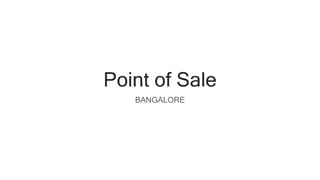Point of Sale systems in Retail
- 2. The Retail Supply Chain and POS Design Buy Make Store Move Sell PLM Supply Chain Performance ERP POS
- 3. What is a POS ? ŌĆ£A point of sale system is a combination of software and hardware that allows merchants to take transactions and simplify key day-to-day business operations.ŌĆØ YAMARIE GRULLON, MANAGER OF CONTENT STRATEGY AT SHOPKEEP
- 4. The Evolution of POS
- 5. POS is prominent ERP is prominent
- 6. Why POS ? Speed ŌĆó Billing ŌĆó Inventory ŌĆó Payroll Knowledge ŌĆó Real Time Sales and Inventory Tracking ŌĆó WhatŌĆÖs hot and whatŌĆÖs not CRM ŌĆó Updated Customer Database ŌĆó Customer Habits ŌĆó Loyalty Management
- 7. POS Deployment Methods On-premise: A traditional software model. Purchase one or more licenses upfront for the software and install it on your computer system or servers. YouŌĆÖre in charge of updating and maintaining the software, which may require dedicated IT personnel for larger organizations. Cloud-based: Also known as Software-as-a-Service (SaaS) POS solutions. You access and support the system via the internet. DonŌĆÖt worryŌĆöif your internet goes down, most systems track sales and sync them once youŌĆÖre back online.
- 8. Hardware Component Register screen: Standard monitor that displays the product database. Enables other functions, such as employee clock-in and viewing sales reports. TabletsŌĆöespecially iPadsŌĆöare popular for replacing bulkier monitors. Barcode scanner: Automates the checkout process. Scanning barcodes pulls product info and adds it to the checkout total. Barcodes, when scanned, may also integrate with inventory management systems to automatically adjust stock levels. Credit card reader: Secure and EMV-compliant credit card readers are extremely important for retailers since the EMV payment standard went live in October 2015, and non-compliant retailers face potentially huge losses on account of fraud liability. Receipt printer: Email and text receipts are gaining popularity, but paper receipts are still important for providing customers with a quick snapshot of their purchase. You can print employee sales totals, hours and other information. Cash drawer: It may fade away in the years to come, but cash is still king. And as long as it is, you need a secure place to store cash for transactions. Additionally, there are no credit card fees tied to accepting cash.
- 9. Must HaveŌĆÖs for a POS
- 10. Modules in a POS
- 11. POS for an Apparel / Lifestyle Segment ŌĆó Intricacies ŌĆó Definition of SKU is complicated ŌĆō Matrix Solution ŌĆó Handling of different sizes ŌĆó Return rates are significant
- 12. Getting Your POS to Run Installation Master Updating SKU Upload PO Creation In warding Merchandise Defining Employees Configuring Printer and Barcodes Integrating EDC / Payment methods Doing Dummy Run Integrating Online *
- 13. Decoding the POS jargon ŌĆó Masters ŌĆó Tax Settings ŌĆó Vendor/Supplier ŌĆó Gift Voucher ŌĆó Item Details ŌĆó Category Details ŌĆó UOM ŌĆó Item Name ŌĆó Attributes ŌĆó Cost and Price ŌĆó Transaction ŌĆó Goods Recd. Note ŌĆó Purchase Order ŌĆó Purchase Return ŌĆó Delivery Challan ŌĆó Sales ŌĆó Sales Return ŌĆó Terminal wise cash Balance ŌĆó Physical Stock Taken ŌĆó Transfer In ŌĆó Transfer out
- 14. Let us look under the hood !! Understanding POS practically














